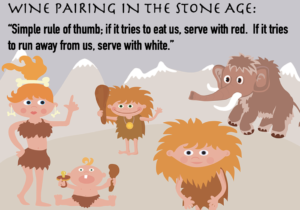 Happy Valentine’s Day!
Happy Valentine’s Day!
Last week, we provided tips on how to prepare the perfect steak for your loved one. Since you are likely preparing a wonderful meal at home or enjoying a meal at a favorite restaurant to celebrate Valentine’s Day, we want to provide some tips on selecting the perfect bottle of wine!
Many years ago, we took a trip to Napa Valley to experience wine country. Although the trip was enjoyable, we really knew very little about wine. (This was back when we first got married and before we discovered all the benefits of REAL food…and certainly before we discovered how matching the right beer or wine to a meal adds so much to the meal experience)!
Since that trip, we have learned more about wine, including trips to the Willamette Valley (Oregon) and Finger Lakes region (New York) and have been able to learn a lot from local experts. While we are by no means “experts,” we want to share some of what we have learned about wine, pairing with meals, plus other tips and suggestions!
How do you pair wines with different types of foods?
First, it’s important to recognize that your wine can change the flavor of your food and vice versa. General rules of thumb are:
- Serve red wine with red meat
- Serve white wine with white meat
- Don’t put bitter food with a bitter wine
Here is a useful resource to help you pair different foods and wines.
Love spicy food? With spicy food, you want a wine with good acidity. They’re more food friendly, and the acidity will help cut the heat (Riesling is a great option). If you pair a hot and spicy food with a dry red wine, it will make the food even hotter! With spicy food you want a juicy, fruity wine with good acidity.
Give them a chance! Rosés are very versatile wines to pair with foods, but they’ve gotten a bad rap. Don’t assume they’re all sweet – or confuse them with White Zinfandels. There are some fantastic dry rosés – and a dry rosé can go with many types of meals!
What temperature is best for serving wines?
Serving wine at the right temperature will help maximize the aromas and flavors. Often, white wines are served too cold and red wines too warm.
- Light white wines, roses and sparkling wines are best served at 40 to 50 degrees.
- Full-bodied whites (like Chardonnay) and light reds are best at 50-60 degrees.
- Full-bodied reds and ports are best at 60 to 65 degrees.
If you need to cool down your bottle, you can put it in a bucket of ice water…about 10 minutes for a bottle of red and 30 minutes for a light white wine.
What does acidity in wine mean?
Acidity in wine refers to the fresh, tart, and sour attributes of the wine. During the winemaking process and in the finished wine, acids play an important role. In winemaking, as the grapes ripen, the sugar increases and the acids decrease. For example, grapes from regions that have a cooler climate generally have higher levels of acidity due to the slower ripening process. Acidity is a key consideration in pairing wine with different types of cuisines.
What does it mean when a wine is dry?
Wine has what are called “tannins” – and tannins are what make a wine taste dry. Tannins are naturally found in plants, seeds, bark, wood, leaves and fruit skins. In wine, tannins add bitterness as well as complexity, so they’re important! Tannins are heaviest in full-bodied wines such as Cabernet Sauvignon, which go well with hearty meals like steak and other red meats.
It’s not always easy to tell by looking at the bottle whether a wine is dry or not. Unless you’re familiar with the grape(s) the wine is made from, you might want to ask someone for help.
How important is where the wine comes from…are some origins better than others?
YES! Many of us don’t think about wine production being seasonal or dependent on the environment and atmosphere, but it is! Grapes are a plant, so they’re affected by the weather, seasons, soil, drought…keep in mind, winemakers are farmers! There are three specific places in California that produce earthy, spicy wines. Oregon and Washington tend to produce more minerality in their wines. Minerality is tricky to explain, but basically refers to the aroma or taste of the wine and what might be referred to as the “earthiness” of the wine. Minerality could be explained as the minerals from the soil that end up in the wine, creating a distinct smell or taste sensation. Where and how the grapes are grown will definitely affect the aroma and taste of the wine. Weather conditions also affect the grapes and the wines, which is why the same wine sometimes tastes different from one vintage to the next.
When cooking with wine, is it OK to use a cheaper wine?
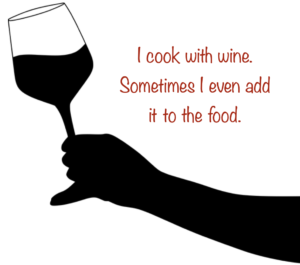 Yes, but the rule of thumb is: If you don’t like the taste of the wine by itself, you probably shouldn’t use it to flavor your food. There are a lot of very good inexpensive wines available – but don’t cook with bad wine — EVER!
Yes, but the rule of thumb is: If you don’t like the taste of the wine by itself, you probably shouldn’t use it to flavor your food. There are a lot of very good inexpensive wines available – but don’t cook with bad wine — EVER!
What if I am serving a meal to kids or people who don’t drink alcohol. Can I still use wine in the recipe?
Depending on the method of cooking, a significant amount of the alcohol in wine will burn off at a temperature of 173 degrees Fahrenheit and especially in recipes with longer cooking times. So go ahead — wine and beer can add great flavor to lots of recipes and foods!
When you see the ratings on wine (such as “87” or “90”), what does that mean and how much value should you put on that rating?
Ratings are scores given by wine experts – but they are still just opinions. Typically, wines are only rated in the mid-80s or above. A 92 is high: It is very rare to see a wine with a rating of 99 or 100, and even more rare to find one at an affordable price. Even though you can rely on the quality of a wine with a high rating, it still may not suit your taste – since everyone’s palette is different.
Are there special tips or recommendations when selecting, enjoying, or storing wine?
- Wine is meant to be relaxing, soothing and enjoyable. Look at each bottle of wine like an adventure…there’s a story that happens with every bottle. It can be at home by yourself, or an evening hanging out with friends or family…whatever the occasion, it’s a story to be savored.
- When storing wine, think about temperature! Wines come in glass bottles. Glass is a heat conductor. Don’t store your wine in a warm kitchen, next to a heat/air vent in your house, by a window, near appliances or on top of the refrigerator. You don’t want to cook your wine! It will turn bad faster if it gets too warm, which is why a basement or dark closet is best. Ask yourself the question…are you displaying it or drinking it?
- Refrigerate rosé wines and lighter grape wines – and even some lighter reds – before opening. If you refrigerate a red wine, remove it from the refrigerator a little while before opening it to let it sweat and allow the flavor of the berries to open up.
What about using a decanter?
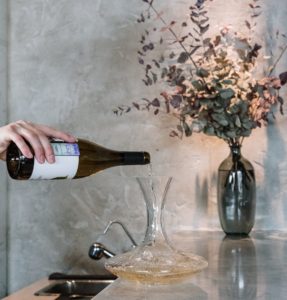 For some wines, a decanter is good…for most, it’s not necessary.
For some wines, a decanter is good…for most, it’s not necessary.
A decanter is a container, typically made of glass, that you transfer your wine into before drinking. Depending on the grape, wine will soften with age, which affects the richness or boldness of the wine.
Decanters are used to expose the wine to air, which helps to age or soften the flavor of the wine. Not all wines are made to be placed in a decanter to soften or even to be placed in a cellar to age. If you have two bottles of the same wine, try decanting one and not the other – and see what you think!
How do you preserve a partially used bottle of wine?
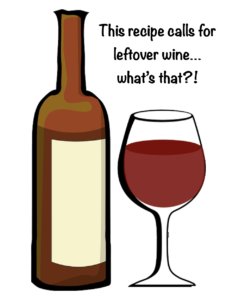 Wine will begin to oxidize immediately after it is opened and exposed to oxygen. Air pumps will help, but will not stop the wine from oxidizing. It’s best to drink and enjoy most wines within 2-3 days. Go ahead…make the sacrifice!
Wine will begin to oxidize immediately after it is opened and exposed to oxygen. Air pumps will help, but will not stop the wine from oxidizing. It’s best to drink and enjoy most wines within 2-3 days. Go ahead…make the sacrifice!
Anything else to keep in mind?
Don’t let choosing “the right wine” stress you out — it’s just fermented grape juice! Don’t let price or ratings be your judge of a good wine. You can find good wines at any price!
Ask! Learn! Experiment!
 Here are a few great recipes to try:
Here are a few great recipes to try:
We want to extend a big thank you to Beyond Napa in Wichita, who has taught us a lot about selecting and pairing wines…and contributed to the helpful tips above.
 LEARN MORE ABOUT THE NAPKIN!
LEARN MORE ABOUT THE NAPKIN!
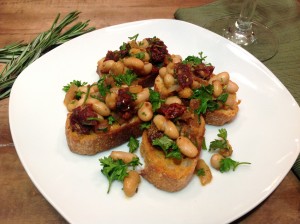
Leave A Comment